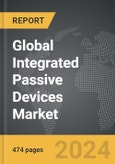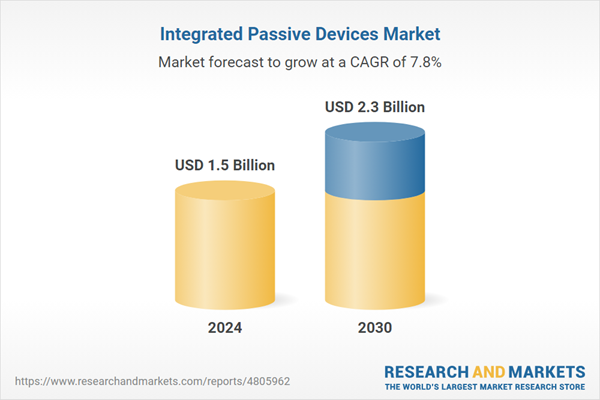The global market for Integrated Passive Devices was valued at US$1.5 Billion in 2024 and is projected to reach US$2.3 Billion by 2030, growing at a CAGR of 7.8% from 2024 to 2030. This comprehensive report provides an in-depth analysis of market trends, drivers, and forecasts, helping you make informed business decisions. The report includes the most recent global tariff developments and how they impact the Integrated Passive Devices market.
IPD technology is pivotal in various wireless communication standards including WLAN, cellular, GPS, and Bluetooth. In WLAN and cellular applications, IPDs are used to miniaturize and enhance the performance of RF front-end modules, enabling more efficient and compact designs. GPS systems benefit from IPDs through improved signal integrity and reduced size, which is crucial for portable and wearable devices. Bluetooth technology, widely used in IoT devices, leverages IPDs to achieve low power consumption and high integration levels, essential for maintaining small form factors. Additionally, IPDs are integral in applications requiring electromagnetic interference (EMI) and electromagnetic susceptibility (EMS) protection, providing robust shielding and filtering solutions.
The growth in the Integrated Passive Devices (IPD) market is driven by several factors. Firstly, the increasing demand for miniaturization and high performance in consumer electronics, such as smartphones and wearable devices, is boosting the adoption of IPDs. Secondly, advancements in wireless communication technologies and the proliferation of IoT devices are creating a significant need for efficient and compact RF solutions, which IPDs are well-suited to provide. Thirdly, the expanding applications of IPDs in automotive electronics, particularly in advanced driver-assistance systems (ADAS) and vehicle-to-everything (V2X) communication, are driving market growth. Lastly, the push for higher efficiency and integration in LED lighting and EMI/EMS protection solutions is further propelling the adoption of IPDs. These factors collectively contribute to the dynamic expansion of the IPD market.
Segments: Material (Silicon, Glass, Other Materials); Wireless Technology (WLAN, Cellular, GPS, Bluetooth, Other Wireless Technologies); Application (EMS & EMI Protection, RF IPD, LED Lighting, Other Applications); End-Use (Consumer Electronics, Automotive, Communications, Aerospace & Defense, Other End-Uses).
Geographic Regions/Countries: World; USA; Canada; Japan; China; Europe; France; Germany; Italy; UK; Spain; Russia; Rest of Europe; Asia-Pacific; Australia; India; South Korea; Rest of Asia-Pacific; Latin America; Argentina; Brazil; Mexico; Rest of Latin America; Middle East; Iran; Israel; Saudi Arabia; UAE; Rest of Middle East; Africa.
The analysts continuously track trade developments worldwide, drawing insights from leading global economists and over 200 industry and policy institutions, including think tanks, trade organizations, and national economic advisory bodies. This intelligence is integrated into forecasting models to provide timely, data-driven analysis of emerging risks and opportunities.
Global Integrated Passive Devices Market - Key Trends & Drivers Summarized
Integrated Passive Devices (IPD) represent a significant advancement in microelectronic technology, providing a means to integrate passive components such as inductors, capacitors, and resistors into a single, compact chip. These devices are primarily fabricated using materials like silicon and glass, which offer excellent electrical properties and mechanical stability. Silicon-based IPDs benefit from the well-established semiconductor manufacturing processes, allowing for high precision and scalability. Glass substrates, on the other hand, provide superior performance in high-frequency applications due to their low dielectric loss and excellent thermal properties. The choice of material depends on the specific requirements of the application, balancing factors such as cost, performance, and integration complexity.IPD technology is pivotal in various wireless communication standards including WLAN, cellular, GPS, and Bluetooth. In WLAN and cellular applications, IPDs are used to miniaturize and enhance the performance of RF front-end modules, enabling more efficient and compact designs. GPS systems benefit from IPDs through improved signal integrity and reduced size, which is crucial for portable and wearable devices. Bluetooth technology, widely used in IoT devices, leverages IPDs to achieve low power consumption and high integration levels, essential for maintaining small form factors. Additionally, IPDs are integral in applications requiring electromagnetic interference (EMI) and electromagnetic susceptibility (EMS) protection, providing robust shielding and filtering solutions.
The growth in the Integrated Passive Devices (IPD) market is driven by several factors. Firstly, the increasing demand for miniaturization and high performance in consumer electronics, such as smartphones and wearable devices, is boosting the adoption of IPDs. Secondly, advancements in wireless communication technologies and the proliferation of IoT devices are creating a significant need for efficient and compact RF solutions, which IPDs are well-suited to provide. Thirdly, the expanding applications of IPDs in automotive electronics, particularly in advanced driver-assistance systems (ADAS) and vehicle-to-everything (V2X) communication, are driving market growth. Lastly, the push for higher efficiency and integration in LED lighting and EMI/EMS protection solutions is further propelling the adoption of IPDs. These factors collectively contribute to the dynamic expansion of the IPD market.
Report Scope
The report analyzes the Integrated Passive Devices market, presented in terms of units. The analysis covers the key segments and geographic regions outlined below.Segments: Material (Silicon, Glass, Other Materials); Wireless Technology (WLAN, Cellular, GPS, Bluetooth, Other Wireless Technologies); Application (EMS & EMI Protection, RF IPD, LED Lighting, Other Applications); End-Use (Consumer Electronics, Automotive, Communications, Aerospace & Defense, Other End-Uses).
Geographic Regions/Countries: World; USA; Canada; Japan; China; Europe; France; Germany; Italy; UK; Spain; Russia; Rest of Europe; Asia-Pacific; Australia; India; South Korea; Rest of Asia-Pacific; Latin America; Argentina; Brazil; Mexico; Rest of Latin America; Middle East; Iran; Israel; Saudi Arabia; UAE; Rest of Middle East; Africa.
Key Insights:
- Market Growth: Understand the significant growth trajectory of the Silicon segment, which is expected to reach US$1.2 Billion by 2030 with a CAGR of a 7.7%. The Glass segment is also set to grow at 8.8% CAGR over the analysis period.
- Regional Analysis: Gain insights into the U.S. market, valued at $416.4 Million in 2024, and China, forecasted to grow at an impressive 10.9% CAGR to reach $336.0 Million by 2030. Discover growth trends in other key regions, including Japan, Canada, Germany, and the Asia-Pacific.
Why You Should Buy This Report:
- Detailed Market Analysis: Access a thorough analysis of the Global Integrated Passive Devices Market, covering all major geographic regions and market segments.
- Competitive Insights: Get an overview of the competitive landscape, including the market presence of major players across different geographies.
- Future Trends and Drivers: Understand the key trends and drivers shaping the future of the Global Integrated Passive Devices Market.
- Actionable Insights: Benefit from actionable insights that can help you identify new revenue opportunities and make strategic business decisions.
Key Questions Answered:
- How is the Global Integrated Passive Devices Market expected to evolve by 2030?
- What are the main drivers and restraints affecting the market?
- Which market segments will grow the most over the forecast period?
- How will market shares for different regions and segments change by 2030?
- Who are the leading players in the market, and what are their prospects?
Report Features:
- Comprehensive Market Data: Independent analysis of annual sales and market forecasts in US$ Million from 2024 to 2030.
- In-Depth Regional Analysis: Detailed insights into key markets, including the U.S., China, Japan, Canada, Europe, Asia-Pacific, Latin America, Middle East, and Africa.
- Company Profiles: Coverage of players such as Infineon Technologies AG, Molex LLC, Bourns, Inc., M/A-COM Technology Solutions Holdings, Inc., Koa Speer Electronics, Inc. and more.
- Complimentary Updates: Receive free report updates for one year to keep you informed of the latest market developments.
Some of the 39 companies featured in this Integrated Passive Devices market report include:
- Infineon Technologies AG
- Molex LLC
- Bourns, Inc.
- M/A-COM Technology Solutions Holdings, Inc.
- Koa Speer Electronics, Inc.
- Darfon Electronics Corporation
- Johanson Technology, Inc.
- Global Communication Semiconductors, LLC
- 3D Glass Solutions, Inc.
- Corry Micronics, Inc.
- Fraunhofer Institute for Reliability and Microintegration IZM
- Allied Components International
- Maxtena, Inc.
- KYOCERA AVX Components Corporation
- JCET Group
Tariff Impact Analysis: Key Insights for 2025
Global tariff negotiations across 180+ countries are reshaping supply chains, costs, and competitiveness. This report reflects the latest developments as of April 2025 and incorporates forward-looking insights into the market outlook.The analysts continuously track trade developments worldwide, drawing insights from leading global economists and over 200 industry and policy institutions, including think tanks, trade organizations, and national economic advisory bodies. This intelligence is integrated into forecasting models to provide timely, data-driven analysis of emerging risks and opportunities.
What’s Included in This Edition:
- Tariff-adjusted market forecasts by region and segment
- Analysis of cost and supply chain implications by sourcing and trade exposure
- Strategic insights into geographic shifts
Buyers receive a free July 2025 update with:
- Finalized tariff impacts and new trade agreement effects
- Updated projections reflecting global sourcing and cost shifts
- Expanded country-specific coverage across the industry
Table of Contents
I. METHODOLOGYII. EXECUTIVE SUMMARY2. FOCUS ON SELECT PLAYERSIII. MARKET ANALYSISCANADAJAPANCHINAFRANCEGERMANYITALYUNITED KINGDOMSPAINRUSSIAREST OF EUROPEINDIASOUTH KOREATAIWANREST OF ASIA-PACIFICLATIN AMERICAREST OF WORLDIV. COMPETITION
1. MARKET OVERVIEW
3. MARKET TRENDS & DRIVERS
4. GLOBAL MARKET PERSPECTIVE
UNITED STATES
EUROPE
ASIA-PACIFIC
Companies Mentioned (Partial List)
A selection of companies mentioned in this report includes, but is not limited to:
- Infineon Technologies AG
- Molex LLC
- Bourns, Inc.
- M/A-COM Technology Solutions Holdings, Inc.
- Koa Speer Electronics, Inc.
- Darfon Electronics Corporation
- Johanson Technology, Inc.
- Global Communication Semiconductors, LLC
- 3D Glass Solutions, Inc.
- Corry Micronics, Inc.
- Fraunhofer Institute for Reliability and Microintegration IZM
- Allied Components International
- Maxtena, Inc.
- KYOCERA AVX Components Corporation
- JCET Group
Table Information
| Report Attribute | Details |
|---|---|
| No. of Pages | 474 |
| Published | April 2025 |
| Forecast Period | 2024 - 2030 |
| Estimated Market Value ( USD | $ 1.5 Billion |
| Forecasted Market Value ( USD | $ 2.3 Billion |
| Compound Annual Growth Rate | 7.8% |
| Regions Covered | Global |









